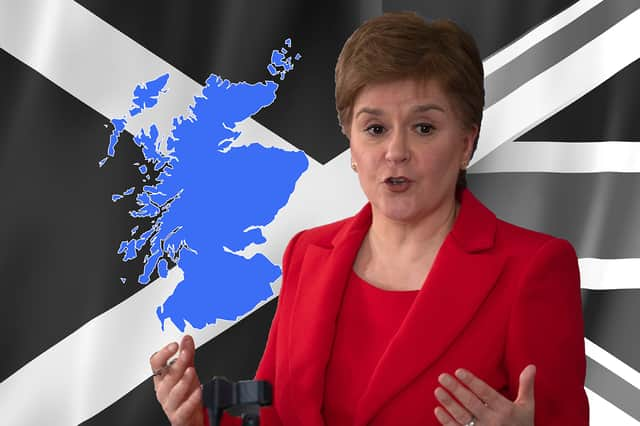Scottish independence referendum 2023: what the polls look like with a year to go until proposed IndyRef2 vote


First Minister of Scotland, Nicola Sturgeon, announced earlier this year that the Scottish Government wants to hold a second referendum on independence on 19 October 2023 – exactly one year today.
Whether or not Scotland will have a second vote lies with the Supreme Court which is currently weighing up the arguments on whether the Scottish government should be allowed to hold a poll without the agreement of Westminster. Whatever the result, voters in Scotland remain split on the issue.
Advertisement
Hide AdAdvertisement
Hide AdIt has been eight years since the first vote on independence in 2014 and a lot has happened since then – Brexit, the Covid-19 pandemic, four different prime ministers, the death of Queen Elizabeth II and now an energy and cost of living crisis.
Despite a tumultuous number of years the polls have remained relatively consistent with neither side taking a dramatic lead, so where will the battlegrounds lie with ‘IndyRef2’?
Elections guru Sir John Curtice, professor of politics at Strathclyde University and senior research fellow at the Scottish Centre for Social Research, said we do not know what will happen if there is a second independence referendum but – unlike in 2014 – Europe and Brexit will be “central to the story”, adding that Brexit and independence were now “very clearly intertwined”.
Loading....
How likely is it that Scotland will vote for independence? With potentially one year to go until a second vote we’ve looked at the data to see where Scotland stands.
Defending Brexit in Scotland
Advertisement
Hide AdAdvertisement
Hide AdDuring the EU referendum in 2016 almost two-thirds of Scotland voted to remain in the European Union, including every single council in the country – but because the UK as a whole voted to leave, Scotland also left the union in 2020. As a consequence Professor Curtice said unionists will have “difficulty” in defending Brexit in Scotland if there is a second vote on Scottish independence.
“Brexit is now playing a role in influencing people’s attitudes towards independence, in a way attitudes about Europe did not in 2014,” he said.
“The choice in another referendum will be very different than in 2014 when it was simply inside or outside the EU, now the choice is inside the UK but outside the EU versus inside the EU but outside the UK. Nicola Sturgeon made it very clear that rejoining the EU, the single market, freedom of movement are all central to the Scottish National Party’s (SNP)’s conception of independence so it becomes a different choice.
Loading....
On Monday, the Scottish Government set out some of its economic plans for an independent Scotland including its commitment to rejoining the EU, its plans on currency and how it would manage debt and investment.
Advertisement
Hide AdAdvertisement
Hide AdCurtice said this was a crucial move to “start the debate” on what an independent Scotland would look like. Nicola Sturgeon said the country would keep using the pound immediately after a vote on independence but set up a new Scottish pound.
“We’ve not had a debate about that choice Scotland faces because of Covid and other issues, it’s only now we have the Scottish government beginning to lay out arguments and beginning to acknowledge things like an implication of a trade border, currency and their argument that it’s better to be in a large single market (EU) than a small single market (UK).
Loading....
“The question is how effective is the ‘yes’ case as it is framed and how effective is the Unionist response. The difficulty the Unionists face is they have to defend Brexit and that’s difficult in Scotland.”
How do the latest polls look?
The latest poll, conducted by Panelbase for the Alba Party between 7 and 11 October, shows a lead for the no vote, albeit with a small margin. The results found 46% said they would vote yes, 49% would vote no and 5% were still undecided. The second most recent poll, conducted by Panelbase for Believe in Scotland between 5 and 7 October, was neck and neck between yes and no with both polling at 47% and undecided making up 6%.
Advertisement
Hide AdAdvertisement
Hide AdThe interactive poll tracker below will show you how attitudes towards Scottish independence have changed since 2014. Can’t see the chart? Click here to open it in a new window.
Loading....
Although the polls show a close contest, the last time the ‘yes’ camp were ahead in the polls was at the start of July (conducted between 29 June and 1 July), just before Boris Johnson resigned as prime minister. The polling by Panelbase for the Sunday Times had yes on 48%, no on 47% and undecided at 5%.
Scotland’s First Minister is also one of the most popular political figures in the UK. YouGov polling for the April to June period of this year shows Sturgeon is the country’s 9th most popular politician with a 25% positive rating. However, at the timeshe was beaten by Boris Johnson with 30% and Rishi Sunak with 26%.
Comment Guidelines
National World encourages reader discussion on our stories. User feedback, insights and back-and-forth exchanges add a rich layer of context to reporting. Please review our Community Guidelines before commenting.
